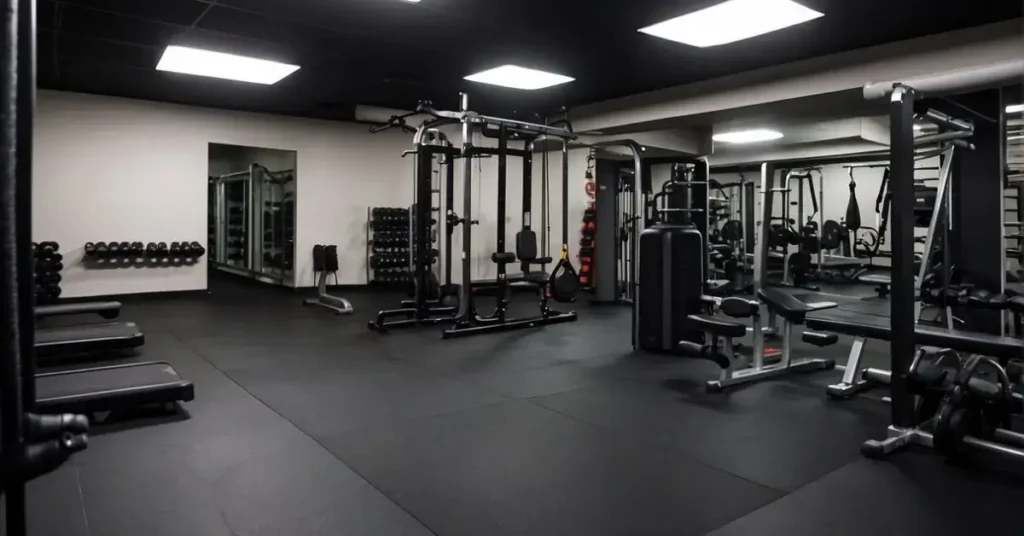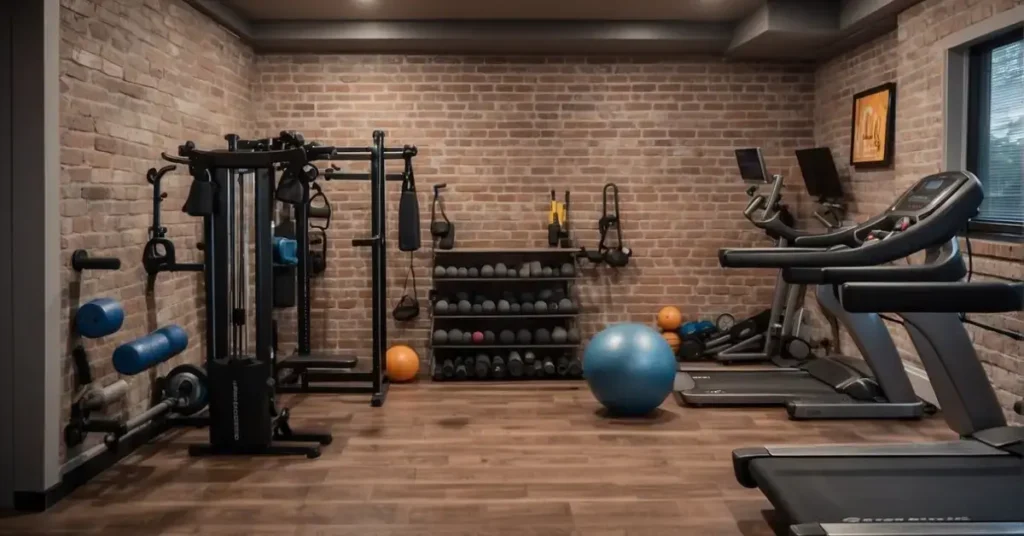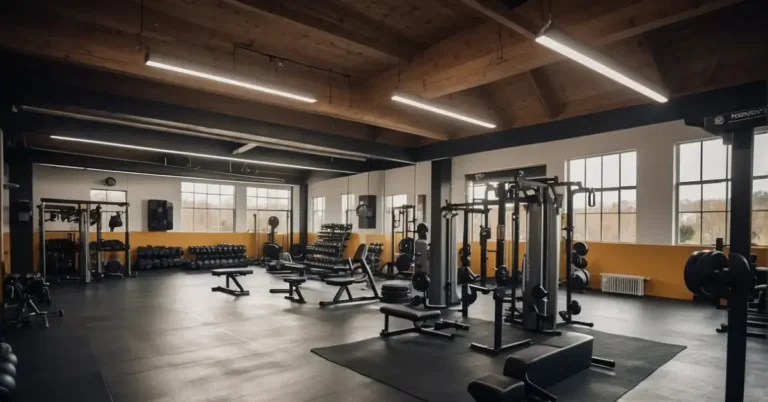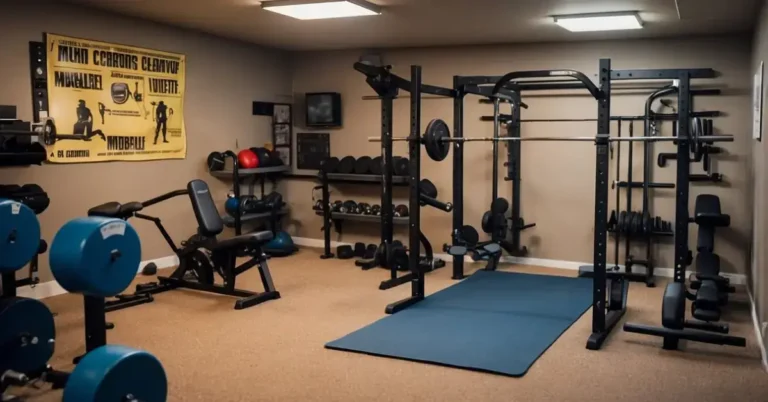Free Shipping On All Orders
Home Gym Ideas Basement: Transform Your Space And Your Body Fast 2024

Designing Your Home Gym Ideas Basement
When we think about creating our home gym ideas basement, it’s not just about cramming in some weights and a treadmill. It’s about crafting a space that inspires our fitness journey and is easy to use.
Assessing the Space
The first step is to measure the dimensions.
We need to know exactly how much room we have to work with, including the ceiling height, which is crucial for selecting equipment that fits.
If we’re working with an unfinished basement, this is the time to plan for renovation to create a clean, safe environment for our workouts.

Selecting a Color Scheme
The colors we choose can deeply affect our motivation.
Let’s choose a color scheme that energizes us.
Bright colors can stimulate, while cool tones can create a calming atmosphere for yoga or stretching areas.
Adding wall decor or artwork to match our theme can make the space more personal and engaging.
We want to steer clear of dull and uninspired—it’s not just a basement; it’s our sanctuary for sweat.
And most important: Check out our full guide on home gym paint ideas and colors!
Incorporating Natural Light and Lighting
Natural light is a luxury in a basement, but if we’re lucky enough to have windows, let’s use them to our advantage by positioning our gym to bask in it.
For those without the gift of sunlight, the right lighting choices can make a world of difference.
Opt for bright, overhead LED lights that mimic daylight and check out our full guide on gym lighting ideas!
Including mirrors can not only help with form but also amplify the light, and if positioned well, can reflect a beautiful view.
Here you can find our full guide on the best home gym mirrors.
Equipping Your Gym
Transforming our basement into an ultimate workout haven starts with the right gym equipment. Let’s make sure we cover all bases—from the pulse-raising excitement of cardio machines to the muscle-toning prowess of strength equipment.
Cardio and Strength Equipment

For achieving that vital balance between cardio and weight training, we’ll need a variety of equipment.
A treadmill or an elliptical machine is essential for warming up and cardio sessions.
But don’t overlook the importance of a squat rack for a solid strength training regimen.
And if space permits, why not add DIY monkey bars or a climbing wall for functional fitness?
- Cardio: Treadmill, Elliptical, Stationary Bike
- Strength: Squat Rack, Adjustable Bench, Free Weights

Training Accessories
Next up are the accessories that perfect our basement gym. From yoga mats for flexibility to punching bags for an explosive workout, these extras can elevate our routine.
For resistance and weight training, adjustable dumbbells are versatile and space-saving, making them a great fit for our home gym ideas basement.
- Flexibility: Yoga Mats, Foam Rollers
- Resistance: Resistance Bands, Adjustable Dumbbells
Technology Integration

To keep us in the zone, a dedicated sound system can blast motivating tunes, while installing a TV can allow us to follow workout videos.
Technology can seamlessly integrate into our workout space, allowing us to track progress or simulate outdoor environments for an immersive experience.
- Entertainment: Sound Systems, Television
- Progress Tracking: Fitness Trackers, Smart Gym Equipment
Ensuring Comfort and Safety

When we set out to transform our basements into home gyms, our foremost concerns are comfort and safety.
From choosing the right flooring to ensuring good air quality and efficient ventilation, and organizing for optimal hygiene and storage, these elements are fundamental in our home gym ideas basement planning.
Flooring Solutions
Basements often have hard concrete floors, which are not ideal for workout activities.
For our safety and comfort, rubber flooring or carpet tiles are excellent choices.
Rubber flooring is sturdy, providing cushioning for our joints during high-impact exercises, and it’s also easy to clean.
Carpet tiles offer a softer surface and can add a touch of warmth to our basement gyms.
Personal Touches
It’s important to add features that resonate with us personally. Hanging motivational posters or painting a chalkboard wall for writing down goals can make all the difference. Imagine doing pull-ups on DIY monkey bars that we crafted ourselves; it adds a meaningful touch and a unique element to our fitness sanctuary.
Comfort
We want our basement gym to be a place we never want to leave. Incorporating luxury in the form of a bathroom can be a game-changer for those heavy workout days. Good air conditioning and natural lighting can minimize distraction and keep us focused on our workout routines.
Air Quality and Ventilation
We can’t overlook the importance of air quality and ventilation.
Basements can be prone to poor air circulation, so integrating air purifiers and fans is crucial.
An air conditioning unit may be necessary to regulate temperature and improve air flow, which helps us stay cool and breathe easier while working out.
Hygiene and Storage
To keep our basement gym clean and clutter-free, hygiene and storage solutions go hand in hand.
Installing shelving or using hooks strategically can help us organize equipment and maintain a neat space.
Regular cleaning is essential, and having dedicated areas for equipment, towels, and sanitizing supplies will ensure our gym remains a hygienic environment for us to enjoy.
FAQ
Transforming a basement into a workout haven with home gym ideas taps into our desire to create a functional, personalized fitness space just steps away from the comfort of our living room.
What’s the best flooring for a basement gym?
Durability: Rubber tiles or mats are ideal — they absorb shock, resist wear and provide comfort.
Safety: Ensure the flooring is non-slip to prevent accidents.
How much space do I need for a basement gym?
Minimum Space: For a basic setup with a few pieces of equipment, aim for at least 50 square feet.
Expansion: Leave room for potential upgrades or additional equipment.
How can I keep the gym well-ventilated?
Air Flow: Use fans or a dehumidifier for air circulation.
Freshness: Regularly open any windows or install an air purifier to keep the air fresh.
What are your experiences with home gym ideas basement? Let us know down below!





